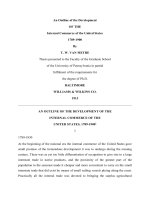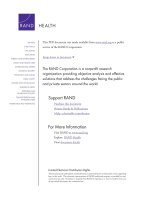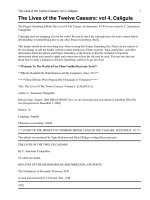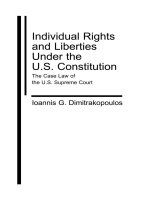MINUTES OF THE MONETARY POLICY COMMITTEE MEETING pot
Bạn đang xem bản rút gọn của tài liệu. Xem và tải ngay bản đầy đủ của tài liệu tại đây (68.87 KB, 10 trang )
Publication date: 19 September 2012
MINUTES OF THE
MONETARY POLICY
COMMITTEE MEETING
5 AND 6 SEPTEMBER 2012
These are the minutes of the Monetary Policy Committee meeting held on
5 and 6 September 2012.
They are also available on the Internet
The Bank of England Act 1998 gives the Bank of England operational responsibility for setting
interest rates to meet the Government’s inflation target. Operational decisions are taken by the
Bank’s Monetary Policy Committee. The Committee meets on a regular monthly basis and
minutes of its meetings are released on the Wednesday of the second week after the meeting
takes place. Accordingly, the minutes of the Committee meeting to be held on
3 and 4 October will be published on 17 October 2012.
MINUTES OF THE MONETARY POLICY COMMITTEE MEETING HELD
ON 5 AND 6 SEPTEMBER 2012
1 Before turning to its immediate policy decision, the Committee discussed financial market
developments; the international economy; money, credit, demand and output; and supply, costs and
prices.
Financial markets
2 Trading volumes in financial markets had been unusually light during August, even allowing for
seasonal variations. Market participants had remained focused on the prospects for changes in policy
in the major economies, particularly in the euro area. Some clarification was expected from the ECB
at its September policy meeting on what steps it would take to reduce the perceived risk of currency
redenomination incorporated into the yields on the sovereign debt of some euro-area member states.
In anticipation of this announcement, Spanish and Italian government bond yields had fallen,
particularly for bonds with short residual maturities, but yields on longer-term bonds had risen in the
second half of the month and, at the time of the meeting, the yield on Spanish ten-year government
bonds was over 6½%.
3 In the United States, interest rates had fallen across the yield curve towards the end of the month
in response to heightened expectations of a possible further loosening in monetary policy. In the
United Kingdom, the majority of respondents to the Reuters survey of economists were anticipating a
further expansion of the Committee’s asset purchase programme at some stage, though this was not
generally expected to be announced at the September meeting. Sterling had appreciated a little further
on the month and was close to the top of the range it had traded in since the beginning of 2009.
4 Sterling Libor rates had fallen further relative to rates derived from overnight index swaps,
continuing a trend that had begun following the announcements of the Funding for Lending Scheme
(FLS) and of the activation of the Extended Collateral Term Repo facility (ECTR). That would put
further downward pressure on lending rates for businesses with floating-rate loans linked to Libor. It
remained too early to assess with any confidence the full scale of the effect the FLS would have on
2
borrowing by the household and corporate sectors, but there had been encouraging signs about the
impact the Scheme was having on lending rates. Two of the largest lenders to the UK corporate sector
had already announced improvements in the terms on some of their lending and there had also been
some further announcements of reductions in interest rates on certain mortgage products, although
some other banks had announced increases. It would probably take some time for banks to review
fully their lending plans, however, and it was likely that drawings from the FLS would be spread out
over the full window to end-2013.
5 Demand for corporate bonds had been robust and issuance by UK non-financial companies had
been strong considering the usual lull in activity during August. Equity prices had risen on the month,
by around 2% in the United Kingdom and United States, and by more than 6% in the euro area.
The international economy
6 The weak tone of data releases on the international economy had continued, and forecasts for
growth in the major economies in 2012 and 2013 had generally been revised down. This weakness
was more marked in indicators of manufacturing and trade, possibly reflecting a slowing in demand for
capital goods against a backdrop of heightened global uncertainty, or a reduction in inventory demand.
7 Activity in the euro area had continued to be subdued. GDP had declined by 0.2% in the second
quarter. Indicators for the third quarter had remained consistent with contraction, and the composite
purchasing managers’ index (PMI) had fallen a little further. Indicators of German output had also
suggested some loss of momentum, following GDP growth of 0.3% in the second quarter.
8 It was likely that activity in many euro-area countries was continuing to be held back by
difficulties in financing public and external deficits. During the month, several regional
administrations in Spain had applied to the central government’s Regional Liquidity Fund, and support
had been announced for individual banks in both Spain and France. Further policy measures at an
area-wide level were expected during the coming months. Alongside possible steps by the ECB to
reduce strains in some sovereign debt markets, European leaders were due to discuss proposals to
introduce a single euro-area bank supervisor and to continue the process of ratifying the European
Stability Mechanism. The European authorities and the IMF were also due to complete their review of
3
the Greek programme during the autumn ahead of a decision on whether Greece would be eligible to
receive the next tranche of funds.
9 The news from the United States had on balance been positive but did not suggest any material
strengthening in output growth in the third quarter. Consumption had increased by 0.4% in July,
following a decline of 0.1% in June, and non-farm payrolls had risen by over 160,000, a larger
increase than recorded on average in recent months. There nonetheless remained uncertainty about
how political negotiations over the extent of budgetary tightening in 2013 would be resolved and this,
alongside developments in the euro area, was likely to weigh on sentiment and demand in the second
half of the year.
10 Indicators for the larger emerging economies had generally continued to be consistent with
activity growth below trend. Manufacturing PMIs had fallen further in Russia, India and China in
August. Some of these declines were likely to be linked to the impact of previous domestic measures
to combat inflationary pressures. But external demand had also slowed over the past year, in part
reflecting lower import growth in the euro area. Monetary policy had since been loosened in a number
of countries, and the governments of both China and Brazil had announced plans to increase spending
on infrastructure. Policymakers generally appeared to have scope to provide more stimulus if that
were deemed appropriate. But it was likely that growth in the major emerging economies would for
some time remain weaker than pre-crisis averages.
11 Oil prices had risen by 8% on the month. Although month-to-month changes of this magnitude
were not that unusual, this was during a period of relatively weak global activity growth, suggesting it
had been caused by supply-side developments. Global oil production had continued to be hampered
by supply disruptions, and it was likely that investors were prepared to pay a premium to hold physical
oil given the recent heightened tensions in the Middle East. The production of industrial metals had
suffered fewer supply problems and prices had generally risen by less. The prices of some agricultural
commodities had remained elevated reflecting droughts in both the United States and parts of
Eastern Europe, but they had not changed much on the month.
4
Money, credit, demand and output
12 The ONS had revised up its estimate of the change in UK GDP in the second quarter by
0.2 percentage points to -0.5%. The revision had largely resulted from smaller estimated contractions
in output in the construction and manufacturing sectors. That would be consistent with the impact on
activity of the additional bank holiday for the Diamond Jubilee having been a little less than the
Committee had previously assumed or underlying growth having been a little stronger. The
breakdown of GDP into its expenditure components suggested that final demand had been particularly
weak, with both investment and net trade subtracting materially from growth, and the only positive
contribution had come from stockbuilding. But these initial expenditure estimates were prone to
revision.
13 Measured GDP could be expected to rise sharply in the third quarter as the Diamond Jubilee
effect unwound, alongside a possible small boost from the Olympics. In line with the usual pre-release
arrangements, the Governor informed the Committee that industrial production had risen by 2.9% in
July, with robust increases in both manufacturing and energy and extraction output. The Markit/CIPS
indices for August had also risen, with increases in activity recorded in both the manufacturing and
service sectors. If the activity indices were to remain at their August levels until the end of the year,
that would be consistent with a modest rate of underlying growth in the fourth quarter. The
expectations and new orders indices, however, which usually gave a better prediction of activity trends
at that horizon, had been weaker and did not yet suggest a return to growth.
14 Any sustained recovery in output would probably need to be accompanied by a pickup in
consumption. The fall in inflation over the previous year and the surprisingly strong rate of
employment growth more recently had together alleviated some of the squeeze on real incomes. There
were some signs that this was beginning to lead to increased spending by households. Retail sales
volumes in the three months to July had been 1.4% stronger than in the previous three months, the
fastest rate of growth since the three months to April 2008. Private car registrations had also risen
firmly over the same period. But other factors cautioned against expecting a lasting upswing at this
stage. Uncertainty remained elevated and this would continue to discourage spending. The
prospective rises in prices for petrol, household energy and some foodstuffs would dampen real
income growth in the second half of the year, and the level of activity in the housing market had
remained moribund. The effect these factors would have on consumption would depend in part on the
impetus given to lending by the introduction of the FLS and the impact of the expansion of the
5
Committee’s asset purchase programme. In this regard it was encouraging that household broad
money growth had picked up during the first half of the year to its fastest twelve-month rate since the
beginning of 2009.
15 The outlook for spending in the rest of the economy was generally weaker. Goods export
volumes had fallen by over 7% in June, concentrated in exports to other EU countries. Forward
looking indicators had been mixed, with the CBI survey of manufacturing recording a drop in export
orders in August, but with the Markit/CIPS export orders indices recovering sharply from their fall in
July. Surveys of investment intentions had fallen back more consistently and many of the contacts of
the Bank’s Agents had downgraded their capital spending plans in light of weakening demand.
Supply, costs and prices
16 Twelve-month CPI inflation had picked up to 2.6% in July from 2.4% in June. The increase had
reflected a rise in the airfares component, which tended to be volatile, and an increase in the
contribution of clothing and footwear price inflation following some earlier than normal summer sales.
17 In line with the usual pre-release arrangements, the Governor informed the Committee that
producer input prices had risen by 2% between July and August, while output prices had risen by
0.5%, both reflecting the recent rises in oil prices. These rises, together with the prospect of further
increases in utility prices not directly related to wholesale energy costs, meant that CPI inflation was
less likely to fall back further during the second half of the year than the Committee had thought at the
time of the August Inflation Report. The increase in the prices of agricultural commodities earlier in
the summer, other things equal, would also begin to be passed through to consumer prices over the
course of the coming year, although other import price pressures had generally remained subdued.
18 The labour market had remained surprisingly resilient in the face of the contraction in activity.
The unemployment rate had fallen to 8% in the second quarter, its lowest level for around a year, and
employment was estimated to have risen by more than 200,000, with a rise in permanent employees
accounting for more than half the increase. It remained difficult to reconcile this with the persistent
weakness in output. Contacts of the Bank’s Agents had suggested that depressed trading conditions
meant employees in some sectors had to work harder to generate new business. Some companies were
likely to have needed to retain a certain minimum level of staff to continue operating, while the
difficulty in recruiting labour with specialist skills may have led others to hold on to some employees
6
currently underemployed. Alternatively, an environment of heightened uncertainty might have led
companies to choose to rely more on increasing staffing as a means of expanding capacity, rather than
investing in plant and machinery which took a long time to come on stream and was more costly to
reverse if demand turned out to be insufficient. Some of the factors contributing to the weakness in
productivity might have persistent effects, for example possible impairment to the efficient allocation
of capital stemming from problems in the financial system. It was unlikely that any one factor alone
could satisfactorily explain all of the conjunction of weak output growth and relatively strong
employment growth.
19 Wage pressures had remained muted. Private sector regular pay in the second quarter had grown
by 2% relative to a year earlier, reflecting subdued settlements. But the continuing weakness in output
growth and strength in employment growth meant that productivity in the second quarter had
disappointed once again, even allowing for the impact of the extra bank holiday. As a result,
notwithstanding the modest rate of wage inflation, growth in unit wage costs had risen. If productivity
growth were to remain weak, wage increases would be held back, but it was also possible that inflation
might fall more slowly than the Committee had previously expected.
The immediate policy decision
20 The Committee set monetary policy in order to meet the 2% inflation target in the medium term.
Inflation was now much closer to target than nine months ago, having fallen from a peak of 5.2% in
September 2011. As inflation had fallen back, the near-term outlook had at various points been jolted
by sharp movements in both directions in the prices of commodities; it was not sensible in such an
environment to ascribe a high probability to any particular short-run projection. That remained the
case this month. Nonetheless, the rise in oil prices and the probable increase in utility and some food
prices meant that the near-term outlook was for a less rapid fall in inflation than the Committee had
thought at the time of its August Inflation Report projections. The outlook for inflation beyond that
point continued to depend on the strength of the headwinds confronting both demand and supply, and
the effectiveness of policy measures in the United Kingdom and abroad in leaning against them.
21 Measured output had continued to be affected by transient factors, obscuring the underlying path,
and GDP growth in the third quarter would be boosted by the unwinding of the Diamond Jubilee
effect. The Committee’s August Inflation Report projections had been consistent with a modest
recovery in underlying activity beginning towards the end of the year and into next year, although the
7
precise timing was uncertain. The robust July Index of Production numbers would require further
study but, alongside the monthly indicators of consumption and the surveys of output in August, they
suggested some modest underlying expansion. Set against that, however, the more forward-looking
components of the business surveys were weaker, and the rise in energy prices would mean that the
squeeze on real household incomes would not ease further in the short term.
22 The slowdown in the global economy, particularly in the euro area, was probably a factor behind
the relatively weak expectations for activity reported by the UK business surveys. Further steps were
likely over coming weeks and months to alleviate strains in the euro area and to provide additional
support for vulnerable member states as they sought to finance public and external deficits and to
rebalance their economies. Nonetheless very substantial risks were likely to remain for some time to
come, which, if they crystallised, could have a considerable impact on the stability of the global
banking system. Even if a disorderly outcome were avoided, it was probable that the threat of such an
event would continue to weigh on domestic economic activity for some time. The risk of a sharper
slowdown in emerging economies could also not be discounted, although monetary policy had been
loosened in a number of countries and further stimulus was possible. The larger Asian economies and
banks were more important to the global trade and financial system than at the time of the Asian crisis
of the late 1990s, so the potential spillovers from a significant slowdown could be greater, although
these would probably also be mitigated by accompanying falls in commodity prices.
23 The extent of a prospective pickup in domestic activity would also depend on how much the FLS
boosted lending to households and firms in an environment in which some banks could otherwise be
seeking to reduce their lending, perhaps materially. The Committee noted that banks would need time
to review fully their lending plans and products, and it was likely to be some while before there would
be drawdowns on a significant scale. Lending rates were thus a more immediate guide to the
Scheme’s impact and it was encouraging that there had been further cuts announced by some banks on
some of their lending products.
24 Turning to inflation, the Committee continued to judge that there was a substantial margin of
spare capacity in the economy, particularly in the labour market. This would continue to bear down on
domestic inflationary pressures for some time. But oil prices had risen again and continuing tensions
in the Middle East meant they could possibly increase further. The further strong growth in
employment in the second quarter had been very welcome but, set against the continuing weakness in
output growth, it implied another fall in measured productivity. Even though the rate of growth of
8
nominal wages remained subdued by historical standards, this continuing fall in productivity meant
that firms’ labour costs were now rising more rapidly. If this continued, businesses were likely at
some point to seek to reduce wage growth or staffing levels. But, in the meantime, there was a risk
that labour cost growth, and so CPI inflation, would fall more slowly than the Committee had
previously anticipated.
25 The Committee discussed whether it was appropriate to modify or continue with the programme
of asset purchases it had agreed at its July meeting. Although there would probably be further
volatility in measured output growth over the rest of the year, the level of demand remained weak and
the outlook was subdued and uncertain. Inflation was considerably lower than a year ago, but it was
still above target and likely to fall back more slowly during the remainder of 2012 than previously
anticipated. The FLS was still in its early stages: it had the potential to reduce funding costs and to
encourage the supply of credit. Set against that, heightened uncertainty, stemming especially from the
euro area, and risk aversion on the part of households and businesses might limit the demand for
credit, making the impact of the FLS difficult to predict.
26 Overall there had been little news regarding the medium-term outlook for inflation. Against that
backdrop, all members agreed that it was appropriate at this meeting to continue with the asset
purchase programme announced at the Committee’s July meeting. For most members this decision
was relatively straightforward, although some of these members felt that additional stimulus was more
likely than not to be needed in due course, while others saw the risks to inflation in the medium term
as being more balanced around the target. Over the next few months, the Committee would gain
further insight into the underlying paths of both supply and demand. It could also take stock of the
impact of past and prospective policy actions, here and abroad. For one member, the decision this
month was more finely balanced, since it was not clear that the uncertainties about the medium-term
outlook would be resolved to any great extent in the coming months and, given the weakness in
demand, a good case could be made at this meeting for announcing more asset purchases.
9
27 The Governor invited the Committee to vote on the propositions that:
Bank Rate should be maintained at 0.5%;
The Bank of England should continue with the programme of asset purchases totalling
£375 billion financed by the issuance of central bank reserves.
Regarding Bank Rate, the Committee voted unanimously in favour of the proposition.
Regarding the stock of asset purchases, the Committee voted unanimously in favour of the proposition.
28 Since the Committee’s previous meeting, it had been consulted over the size and terms of the
Bank’s ECTR facility, in advance of the monthly auction on 15 August.
29 The following members of the Committee were present:
Mervyn King, Governor
Charles Bean, Deputy Governor responsible for monetary policy
Paul Tucker, Deputy Governor responsible for financial stability
Ben Broadbent
Spencer Dale
Paul Fisher
Ian McCafferty
David Miles
Martin Weale
Dave Ramsden was present as the Treasury representative.









